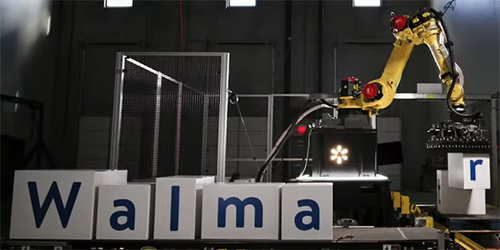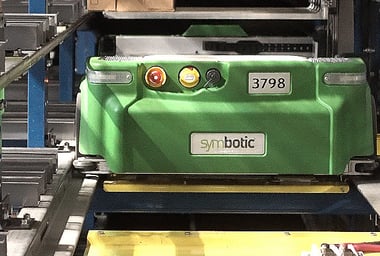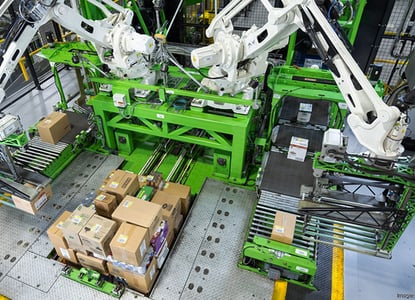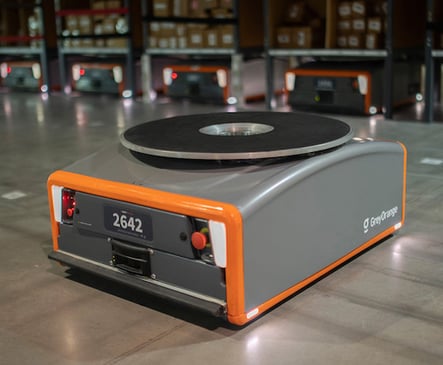What’s New in Robotics? 21.04.2023

Posted on Apr 21, 2023 8:07 AM. 8 min read time
News briefs for the week take a look at the week’s biggest announcement: Walmart’s recent blockbuster 5-year plan to go all-in on robotics and automation (April 5). By 2026, Walmart claims that 65% of its retail operations will be totally serviced by automation. Winning robotics vendors in the Walmart plan: Symbotic, GreyOrange, and Alert Innovation.
Walmart Goes All-In for Robots!
A massive upside for entire robotics industry
At Walmart’s April 5th Investment Community Meeting, a giant of an industrial robot opened the conference, picking up large white blocks with blue letters on them from a pallet, and then proceeding to spell out Walmart, block by block, which was a definite clue as to where the meeting’s agenda was headed.
 Doug McMillon, president of Walmart, wasted no time in announcing to his audience: “We’ve been methodically building our next-generation supply chain and now we’re ready to launch its 5-year plan.”
Doug McMillon, president of Walmart, wasted no time in announcing to his audience: “We’ve been methodically building our next-generation supply chain and now we’re ready to launch its 5-year plan.”
Walmart is finally going all-in for robots, and its competition will no doubt quickly follow suit, as did Walmart itself after watching Amazon’s robots make it an industry leader.
If robots are good for Amazon, they must be good for all of us, seems to be the thinking from Walmart. Just have to find the right combination. Since 2014, Walmart has experimented with robots, and now has fully committed itself to robot-driven automation.
Sales of logistics robots and systems, mobile, stationery, or otherwise, which are swiftly tracking upwards the last three years, will probably skyrocket in view of Walmart’s recent bet on robots.
At a behemoth distribution center in Brooksville, Florida, about 50 miles from Tampa, Walmart has begun to roll out its master blueprint for operations over the next five years (2023-2028).
The 5-year plan shows Walmart finally going all-in with automation and robots, and the Brooksville DC is the poster child of where that plan is taking Walmart. Brooksville is the size of 24 football fields, that’s 1.4 million square feet (130,000 square meters), where today 200,000 square feet are totally automated, and the remaining 800,000 square feet will quickly follow.
With that 800,000-square-foot final expansion, explained David Guggina, Walmart's executive vice president of supply chain, throughput of goods will double.
Double, as in twice as much!? Yes, and it’s sure to make every robot vendor grin broadly, for sales are sure to follow.
 Where once workers manually unloaded goods from trailer trucks, now autonomous forklifts do much of the work. Warehouse worker, Jose Molina, approves, saying that the old system was physically demanding and filled with confusing paperwork. Molina added that now when his shift is over, he doesn’t go home totally fatigued. He and his crew only have to step in when the automation needs help…which is infrequent. All of which make for an easier workday.
Where once workers manually unloaded goods from trailer trucks, now autonomous forklifts do much of the work. Warehouse worker, Jose Molina, approves, saying that the old system was physically demanding and filled with confusing paperwork. Molina added that now when his shift is over, he doesn’t go home totally fatigued. He and his crew only have to step in when the automation needs help…which is infrequent. All of which make for an easier workday.
The killer stat released in Walmart’s announcement: “Within three years, the unit cost of moving goods will fall 20% as warehouse robots play a larger role in speeding goods to customers.”
As the sub-headline in Digital Commerce 360 read: “By the end of 2023, about a third of Walmart stores will be served by distribution centers where warehouse robots do much of the work.”
That’s only eight months off!
Symbotic: Walmart’s automation vendor
According to Walmart’s blueprint, Massachusetts-based Symbotic, already automating 25 of Walmart’s distribution centers, will get all 42 of the retailer’s U.S. distribution centers. A process that Symbotic reports will take eight years to complete.
 Symbotic, formerly owned by billionaire Rick Cohen, who already owns mega-supplier C&S Wholesale Grocers Inc., the country’s largest wholesale grocery distributor by sales, is now (as of 2022) a publicly traded company through completion of business combination with SoftBank-sponsored SVF Investment Corporation.
Symbotic, formerly owned by billionaire Rick Cohen, who already owns mega-supplier C&S Wholesale Grocers Inc., the country’s largest wholesale grocery distributor by sales, is now (as of 2022) a publicly traded company through completion of business combination with SoftBank-sponsored SVF Investment Corporation.
“Our vision at Symbotic has always been to reinvent the supply chain with artificial intelligence and robotics – transforming the distribution network into a strategic asset,” said Cohen, now chairman of the board of directors and president of Symbotic
 “We believe Symbotic is at the forefront of a more than $350 billion market opportunity to reinvent warehouse automation and reshape the global supply chain,” said Vikas J. Parekh, managing partner for SoftBank Investment Advisers and a member of Symbotic’s board of directors.
“We believe Symbotic is at the forefront of a more than $350 billion market opportunity to reinvent warehouse automation and reshape the global supply chain,” said Vikas J. Parekh, managing partner for SoftBank Investment Advisers and a member of Symbotic’s board of directors.
Walmart recently disclosed that it owned shares of Symbotic; in a regulatory filing Walmart stated that it holds 15 million Class A shares of as June 21, 2022.
How exactly Symbotic will drive savings for Walmart’s blueprint over 42 warehouses and distribution centers is yet to be seen, however, big clue from Symbotic shows food retailers and wholesalers cutting distribution-center labor costs by 80% and operating warehouses that are 25% to 40% smaller.
In an industry with razor-thin margins (1% to 2%), such savings are mind-boggling.
Walmart (Alberta, Canada) taps GreyOrange for DC in Calgary
Capable of storing 500,000 items to fulfill direct-to-home and in-store pickup orders, as well as capable of shipping 20 million items annually from the facility to Walmart customers in Western Canada, the giant retailer cut the ribbon on a Walmart (Alberta, Canada) warehouse just outside of Calgary that’s 430,000 square feet and cost more that $118 million to build.
Says Walmart: “This development is part of Walmart Canada’s $3.5 billion investment to make the online and in-store shopping experience simpler, faster and more convenient for continued growth in Alberta and across Canada.”
Like its 42 other warehouses in the U.S., the Calgary facility will be fully automated, but not by Symbotic. This time around, “robotic technology from GreyOrange will be used.”
GreyOrange, still calling itself a startup although founded in 2009, in India by then- students Samay Kohli and Akash Gupta, is now showing $142 million in VC money, a net worth north of $1.7 billion, offices worldwide, world headquarters in Altlanta, Georgia since 2018, with its tech gear in the warehouses of 38 customers, according to Economic Times of India. That’s way not a startup!
One of the first of the KIVA-class lookalikes, GreyOrange continues to evolve itself, and now, 14 years later, is the vendor of choice for Walmart’s Calgary DC. In October 2021, Walmart sister company Sam's Club implemented GreyOrange technology within its innovation-focused fulfillment center in Perris, California.
The Calgary DC will take advantage of GreyOrange’s recently (2023) released API that enables “any vendor’s robotic solution to seamlessly connect to the GreyMatter fulfillment orchestration platform, giving customers the freedom to choose the technology that fits their warehouse environment.”
The GreyMatter group includes vendors such as HAI Robotics, Fetch Robotics (now Zebra), Mushiny Intelligence, Technica International, Vicarious and Youi Robotics, among others, says GreyOrange CEO and co-founder Samay Kohli.
Walmart acquires Alert Innovation’s Alphabots
Last October (2022), Walmart acquired robotics company, Alert Innovation (headquartered in Andover, MA), which was no stranger to Walmart. Alert and its e-commerce Alphabots have a history of working the company’s stores. Primarily working on a multi-year pilot of the company’s robotic grocery order-fulfillment technology.
Alphabot will continue to automate Walmart’s order processes, which will now scale out to serve 4,700 stores. With the deal, Alert cemented its already close relationship with Walmart after developing Alphabot technology specifically for the retailer.
Alert’s Alphabot System operates within a 20,000-square-foot space, using autonomous carts to retrieve groceries, including chilled and frozen items. The carts are capable of moving both horizontally and vertically.
Two things jump out right away in this blockbuster announcement: 1. Retailers do not have to be developers of their own robot-driven automation (like Amazon) to succeed; 2. Mega-customers like Walmart will drive permanence in interoperability across the robotics industry. Similar to what happened in the computer industry decades ago, proprietary systems look to be kaput!


Leave a comment